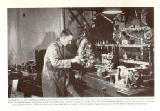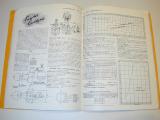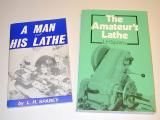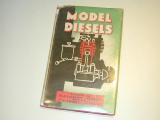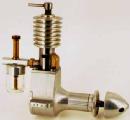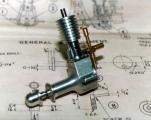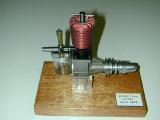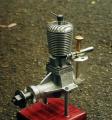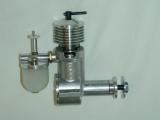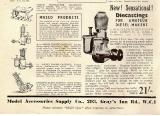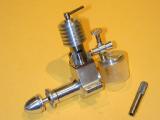Lawrence H Sparey's Diesels
Click on images to view them in larger size and more detail.
Updated: September 2005.
Last update: July 2011.
"In common with that of most other foundations of civilization, the origin of the lathe is lost in the darkness of time."
So begins Chapter 1 of The Amateur's Lathe, by Lawrence H Sparey. Although his name is inextricably linked with two long lasting IC engine designs that remain popular with the home-construction fraternity, details of Mr Sparey himself are in danger of suffering a similar fate. This page has been constructed to delay this day.
Sparey, along with his prolific countryman, Mr Edgar T Westbury, was a pioneer of model internal combustion engines for home construction in Britain of the 1940's. In May 1946, the British Aeromodeller magazine published plans and instructions for a 5cc diesel engine specifically aimed at the home constructor. Although credited to the "Aeromodeller Research Staff", this is now recognized as Sparey's work. Exactly one year later, the May 1947 issue of Aeromodeller carried plans and construction details for a "..smaller edition [of] the compression ignition engine.." (note the use of the correct approbation), this time credited to Lawrence H Sparey. A few months earlier, experiments by HH Groves in producing one-half and one-third scale reductions of the 5cc engine had appeared in a magazine edited by LHS.
At this time, the firm Drysdale Press published three magazines. These were Aeromodeller, Model Cars, and Model Mechanic, the latter edited by Sparey. Six months earlier, beginning in Volume 1 Issue no 7, dated Dec/Jan, 1947, Model Mechanic had carried this same design as a two part construction series.
In November 1951, Drysdale merged Model Cars and Model Mechanic into Model Maker which continued on until February 1966, after which it transformed into Model Boats under Vic Smeed. Confused yet? The Model Maker carried occasional engine related projects and articles from various authors, including Edgar T Westbury, and LBSC (aka Lillian "Curley" Lawrence). Both LBSC and Westbury were regular contributors to the Model Engineer, then a rival publication which was brought under the one roof with Aeromodeller and Model Maker in December 1965. The first issue of Model Maker, dated November 1950, listed LH Sparey as co-editor along with Mr GH Deason, previously the editor for Model Cars. The second issue listed only Deason as editor (pay attention, there will be a test later...)
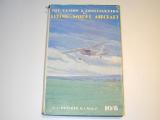 During this period, all three magazines had Mr DJ ("Dickie") Laidlaw-Dickson as Public Relations Officer and Mr DA Russell as the Managing Editor. Russell was author of The Design and Construction of Flying Model Aircraft seen here. He was also the builder of a rather infamous, frequently featured, giant 1/4 scale Westland Lysander, initially intended for free-flight.
During this period, all three magazines had Mr DJ ("Dickie") Laidlaw-Dickson as Public Relations Officer and Mr DA Russell as the Managing Editor. Russell was author of The Design and Construction of Flying Model Aircraft seen here. He was also the builder of a rather infamous, frequently featured, giant 1/4 scale Westland Lysander, initially intended for free-flight.
While Editor of Model Mechanic, Sparey contributed a number "tools to make models" related articles. Several items appearing under nom de plumes also look suspiciously like his work, especially given that one of these, detailing parallel laps for IC cylinders, also appears in his book. The accredited articles appearing in "Model Mechanic" are shown below:
- Tailstock Turret Tool Holder, Apr/May 1947 †
- Home Made Collet Set, Oct 1947 †
- A .8cc Diesel, Dec 46/Jan 1947
- A Change Wheel Dividing Head, Jan 1948 †
- Saw Bench Incorporating a Saw Table for the Lathe, Mar/Apr 1948
- A Micrometer Boring Head, Nov 1948
- An Improved Lathe Change-Wheel Quadrant (patent applied for), May 1949
- Motorized Self-Acting Hand Shaper, Dec 1949
- A 47cc Two-Stroke Petrol Engine, Jan/Feb 1950
- Screw Cutting Gearbox, Mar 1950, and Apr 1950
(† Plan reprinted in "The Amateur's Lathe")
Sparey's work with Aeromodeller magazine included developing their first engine test procedures and writing monthly engine test reports between May 1948 and May 1952. During this 49 issue period, he tested 47 engines, producing BHP and torque curves for each using apparatus he had designed for this purpose. His first Engine Analysis was of Electronic Developments' (ED) "Competition Special", seen here in reprint form with an example of the delightful, isometric cut-away drawings that accompanied each of his reviews. His last Engine Test report was on the famous Mills 0.75cc diesel. In June 1952, the series restarted under Ron Warring and the name Sparey disappeared from the pages until his obituary notice in Aermodeller Volume 61, Issue 611 of December 1986.
The front piece photos in his books, "The Amateur's Lathe" (1948), and "A Man and His Lathe" (1951), show a thin man of rather indeterminate age, with an aesthetic look (I'm reminded of Allan Turing). LHS's passing received greater coverage in companion magazine, Model Engineer Volume 157, Issue 3789 of November 1986. From this source we learn that he was 86 at the time of his death and had lost his sight some years previously. We also learn why his engine tests disappeared from Aeromodeller. Sparey, ever the pioneer, was the subject of one of the first, if not the first noise abatement complaints to be brought by the North London Council. It seems he took the tests very seriously, thoroughly breaking-in the test engines before conducting test runs under different conditions to average the results. That he did this at all hours appears to have been too much for the council and LHS was forced to cease and desist, thus putting an end to his column in Aeromodeller.
Ron Warring's 1952 Engine Review feature was labelled "New Series" and the numbering wound back to one. Warring himself completed 127 Engine Review articles, each with power curves, most with disassembled photos, although the cut-away drawing feature was dropped. His first in June of 1952 was the Mk I ED Baby; his last appeared in the Nov 1964 issue.
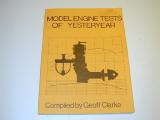 Model and Allied Press (MAP) took over from Drysdale Publishing and gave re-print permission for selected Sparey and Warring engine reviews to a venture called "MM Publishing". This relatively rare (today) book was called Model Engine Tests of Yesteryear. Underscoring some close connection, while MM was listed as the publisher, MAP was listed as the printer.
Model and Allied Press (MAP) took over from Drysdale Publishing and gave re-print permission for selected Sparey and Warring engine reviews to a venture called "MM Publishing". This relatively rare (today) book was called Model Engine Tests of Yesteryear. Underscoring some close connection, while MM was listed as the publisher, MAP was listed as the printer.
In the May 1954 issue of Aeromodeller, an article by Warring and Mr E Hook appeared showing an Eddy Current Dynamometer of their design. Warring stated that this would now be used in all further tests as "..apparatus inherited with the job were of an appreciably lower order than would be anticipated." Hardly complimentary of Sparey's pioneering work, though ten points to Aermodeller for admitting that their previously published figures had been optimistic. With Warring's departure, the chair was vacant for some time before being taken over by Peter Chinn in January 1966.
The by-line, "PGF Chinn" had appeared under engine related articles in rival British publication, Model Aircraft as far back as 1948, making Chinn a contemporary of Sparey, et al. In an act of closure, Model Aircraft ceased publication with the December 1966 issue and merged with Aeromodeller. Peter Chinn also appeared on the other side of the Atlantic in the "Foreign Notes" column of Model Airplane News, commencing with the March 1954 issue. This would make him probably the more prolific of all three as this column continued well into the 1980's. He also took over their engine review series when the "new look" was introduced in 1978.
Sparey's 5cc design was reprinted in the book Model Diesels edited by then Aeromodeller Public Relations Officer (today, we'd probably call this position Advertising Manager), DJ Laidlaw-Dickson. This book was published in 1946 and updated in 1947. The revised edition of 1947 claims that over 1000 copies of this engine had been so far made, worldwide.
As already noted, Sparey himself authored at least two books aimed at model engineers. The first, The Amateur's Lathe, appeared first in 1948 and has an astounding reprint history, remaining in almost continuous publication up to the present day! My copy notes that there was a ninth impression in 1986, then a further six reprints spanning 1987 through 1994. Although some of the material has dated, it remains largely relevant to model engineers and contains a photo of the 5cc design as a complete engine. Modestly, Sparey does not claim credit for the engine's design in his book which to a degree, draws on photographs and drawings taken from Sparey's workshop tool projects as printed in Model Mechanic. A second, smaller volume whimsically titled, A Man and His Lathe, followed in 1951. This book details a number of Sparey's suggestions for modifications and additions to the Myford Series 7 lathes. It too, is available in reprint.
The Sparey .8 (sic) pictured here was made by Ken Croft of Yarm, UK in 1987 and was his third engine. Ken states it turns an 7x4 prop at 5600 RPM. What makes Sparey's .8cc (sic) most interesting is why I keep having to say ".8cc (sic)"! This engine has a (nominal) 5/16" bore and a 1/2" stroke. Multiply this out and you get 0.038 cuin. Apply the conversion factor (dividing by 0.061 is close enough) and we find the engine is 0.628cc, not 0.8cc. How could a man of Sparey's experience get this so wrong? I've played with the numbers and can come up with no reasonable explanation. We can safely assume he worked in imperial measurements as most dimensions are given in fractions. This being the case, the metric capacity would be derived by either linear or volumetric conversion factors. Whatever way, there are too many variables to reproduce the error. Did he use log tables, long division/multiplication, a nomograph? He certainly could not have used a pocket calculator! Perhaps it was not him after all; was it the staff, or draftsman at Drysdale?
The most credible explanation yet comes from Barry Wade, a Model Engine News reader in the UK. I'd forgotten about slide-rules (even though my academic studies span the times during which slide-rules, and later calculators were first permitted into Australian exam rooms). Barrie demonstrates here most convincingly how positioning the cursor over the wrong pie will produce 0.049 cuin (0.8cc). Thanks Barrie; I think we can now say the mystery is solved.
This is my theory: First, Sparey never did call his engine ".8cc". Although titled "A .8cc Diesel", nowhere does his text mention the displacement in any units (the Aeromodeller and Model Mechanic texts are identical). Next, kits for both of Sparey's designs were produced in the UK by a firm called The Model Accessories Supply Co who marketed them heavily in Model Machanic and Model Cars as the Masco 5cc and Masco .8cc, thus perpetuating the myth and making it politically difficult for Sparey to contradict a firm that booked two color, full cover-page ads to market kits to the editor's designs. Finally, Drysdale Press was also advertising the plans (at 3/6, or 35p) for the design under the same title, cross referencing MASCO as suppliers of the castings. Hence, the error, originating with the drawing title block, has been perpetuated through the publisher and advertiser so that even today, the engine continues to be known as the "Sparey .8cc" (of .62cc capacity  ).
).
This was the first engine I made. The plaque on the stand proudly states, "April, 1996", which is why I must continue to call myself a beginner at this craft. However, it ran and that was a big thrill for me, even if the skin on the rice pudding was in no immediate danger. I purchased the kit and plans for the engine from Woking Precision Models in the UK and doubting my ability to complete it without some kind of disaster, acquired a second set as a spare at the same time. In the event, the first was completed with only the con rod needing replacement when the first was thrown across the shop by the buffing wheel and never seen again! So the second has sat quietly under the bench ever since, waiting to be built as a real .8cc. The photo here is of my first engine.
The 5cc Sparey appeared first in Model Mechanic, Volume 1, Issue #2, June 1946, and with an economy typical of DA Russell as Managing Editor, was repeated later in Aeromodeller (some of Sparey's Aeromodeller Engine Reviews were also reused in "Model Cars"). It appears to be the first published English design for a compression ignition engine intended for home construction. Construction plans for this type of engine had appeared on the continent during World War II, notably the Nova 1 in German occupied Holland during 1943. A one hundred percent faithful Sparey 5cc would be a rare bird indeed. On both of Sparey's designs, the driver washer incorporated a pulley for a starting cord. The photos here show two Australian examples. The one on the left was built by Mr Russell Watson-Will, whose extensive library provided much of the research material for this article. Russ pays homage to the original with a starter pulley shaped prop driver. The other is by Mr Phil Coleman. This is very close to original, except for said prop driver which has been made to more accepted, modern practice.
The 5cc Sparey engine formed the basis of first model engine built by Motor Boy Fellow, Gordon Burford. Gordon named this the "GeeBee 1" and exhibited it at an exhibition in Adelaide, Australia, where it took second prize and was promptly stolen. Many years later, he and David Owen have collaborated to produce a limited edition reproduction as pictured here, although it's hard to spot the Sparey ancestry. History has a fine symmetry. Forty years later, Gordon's stolen engine came into the hands of Texas Motor Boy, Bert Striegler. Bert sent a photo of his "Sparey" engine to Model Engine World where Gordon saw and recognized it. Bert immediately sent it home—along with a contra piston fitted with an O ring he'd made to replace a missing item. Gordon says that that's now the way he'd have done it.
By co-incidence, the first engine Bert made had also been a Sparey 5cc! Bert's engine is shown here, fitted with a Perry carb as he put it in a Keil Kraft Junior 60, a large model designed as free-flight with occasional radio interference. By more strange coincidence, the Junior 60 was the first radio control model that I built back in the good old days when we had to build our own radios using vacuum tubes! Bert's engine is close to the original plans and highlights some of the changes in the GB1. Most noticeable are the external bypass and screwed on cylinder cooling fins. The fore-aft fins on the head are cut after the "tightened down" location has been established. Both features that would make mass, or even limited production expensive. Bert has also taken some artistic license with the very unique, arty jacket fins.
Another engine authority, author and contemporary of the gentlemen already mentioned was Lieutenant-Colonel CB Bowden. Bowden's book Diesel Model Engines was first published in 1947, then revised in 1949 and again in 1951. It was reprinted, along with his other engine related books by TEE Publishing in 1993. The TEE versions pictured here are reduced in size from the originals, perhaps to achieve better apparent quality in the reproduction process.
In his book, Bowden states that "..Mr. Lennan, of Scotland, first built a diesel in 1943, which was slowly developed over a period of two years. Mr. Sparey started experiments in 1944." Later he contradicts this saying that Sparey gave lectures and demonstrations of his diesels to clubs and societies, and that "As far as is known, he was the first one to design and make a model diesel in Britain early in 1944. He built this engine from "rumours" he got about continental diesels from soldier friends returning from abroad." Or perhaps Bowden did not consider Scotland to be part of Britain? 
Bowden's book does however lead us to another engine, stating that the 2.8cc "Buzzard" was designed for Masco by Sparey and Russell. The December 1949 issue of Model Cars carries another Model Accessories Supply Company advertisement for the Sparey 5cc and .8cc(sic) casting sets and announces this "sensational" new design by Sparey and Russell, adding that it is "[the] only engine covered by the all embracing master patent No. 593551. Original prototype application dated 4th June, 1945."
Mike Clanford's A to Z of Model Aircraft Engines carries a picture of the Masco Buzzard, but fails to record the Sparey/Russell connection, although the he correctly identifies it as a kit engine and very nearly gets the manufacturer's name right. The die cast crankcase is apparent in both photographs, making its "kit" origin less obvious today. However, it has been reported by an owner of an original casting that the quality is not precisely as stated in the company's advertisements!
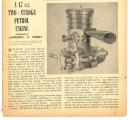 One more Sparey engine design can be found in Model Mechanic of Jan/Feb 1950. The Managing Editor's giant 1/4 scale Lysander was still sans suitable powerplant. According to the article, DJ Russell had prevailed upon Sparey to produce a suitable engine, so he built the prototype shown here. The article presents only information and 3 views, concluding with "..full working drawings will be presented [in Model Mechanic] as soon as they have been prepared from the sketches that served for the prototype". The last issue of Model Mechanic is dated "Sep/Oct 1950" and carries an add by Drysdale Press for a 45cc two stroke engine (note the reduction in capacity from the prototype) designed by LH Sparey, suitable for a "motor mower". This design must have appeared in the July and/or August issue of the magazine. Unfortunately, I have not been able to track down copies to verify this.
One more Sparey engine design can be found in Model Mechanic of Jan/Feb 1950. The Managing Editor's giant 1/4 scale Lysander was still sans suitable powerplant. According to the article, DJ Russell had prevailed upon Sparey to produce a suitable engine, so he built the prototype shown here. The article presents only information and 3 views, concluding with "..full working drawings will be presented [in Model Mechanic] as soon as they have been prepared from the sketches that served for the prototype". The last issue of Model Mechanic is dated "Sep/Oct 1950" and carries an add by Drysdale Press for a 45cc two stroke engine (note the reduction in capacity from the prototype) designed by LH Sparey, suitable for a "motor mower". This design must have appeared in the July and/or August issue of the magazine. Unfortunately, I have not been able to track down copies to verify this.
LH Sparey's published designs have been continuously available for over 50 years through a succession of copyright holders. Currently they can be ordered through Nexus Publishing (be warned, this is not a well thought out site). The plan number references are:
- 5cc diesel, MM122
- .8cc(sic) diesel, MM123
- 45cc ignition, MM185
I've often thought that I should build my spare kit as a real .8cc. While chatting by email with the other Motor Boys on the eve of the zero-based millennium in December 2000, Ken Croft posed this teaser: "why not build a twin Sparey?" That idea really took root and some quick CAD followed. In the process, I found that .8cc would be easily achievable if the bore was enlarged to 11/32", giving 0.46 cuin (0.076cc). This reduces the cylinder walls to 0.047" thick, so I played with increasing the cylinder outside diameter from 7/16" to 1/2" (strangely, the cooling head is threaded as if the cylinder was already 1/2"). With this much extra wall to play in, it was no effort to further increase the bore to 0.394" to give a capacity of exactly 1cc and so was born the Sparey .8cc (sic), Millennium Edition pictured here, which has about the same amount of error, but in the other direction!
In the meantime, Ken and I had decided on a basic design for the twin that we were happy with and he started making chips. These pages then will show the three engines we will build from this madness.
![]()
 Home
Home
Please submit all questions and comments to [email protected]
This material (C) Ronald A Chernich, 2000-2011. All rights reserved, worldwide. Material may not be copied nor reproduced in whole or part without the express, written permission of the author.
